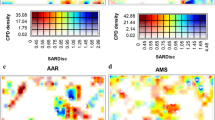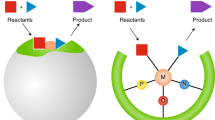Abstract
Generative topographic mapping (GTM) approach is used to visualize the chemical space of organic molecules (L) with respect to binding a wide range of 41 different metal cations (M) and also to build predictive models for stability constants (logK) of 1:1 (M:L) complexes using “density maps,” “activity landscapes,” and “selectivity landscapes” techniques. A two-dimensional map describing the entire set of 2962 metal binders reveals the selectivity and promiscuity zones with respect to individual metals or groups of metals with similar chemical properties (lanthanides, transition metals, etc). The GTM-based global (for entire set) and local (for selected subsets) models demonstrate a good predictive performance in the cross-validation procedure. It is also shown that the data likelihood could be used as a definition of the applicability domain of GTM-based models. Thus, the GTM approach represents an efficient tool for the predictive cartography of metal binders, which can both visualize their chemical space and predict the affinity profile of metals for new ligands.











Similar content being viewed by others
References
Varnek A, Baskin I (2012) Machine learning methods for property prediction in chemoinformatics: quo vadis? J Chem Inf Model 52(6):1413–1437. doi:10.1021/ci200409x
Cherkasov A, Muratov EN, Fourches D, Varnek A, Baskin II, Cronin M, Dearden J, Gramatica P, Martin YC, Todeschini R, Consonni V, Kuz’min VE, Cramer R, Benigni R, Yang C, Rathman J, Terfloth L, Gasteiger J, Richard A, Tropsha A (2015) QSAR modeling: where have you been? Where are you going to? J Med Chem 57(12):4977–5010. doi:10.1021/jm4004285
Kubinyi H, Muler G (2004) Chemogenomics in drug discovery. Wiley, Weinheim
Varnek A, Baskin II (2011) Chemoinformatics as a theoretical chemistry discipline. Mol Inf 30(1):20–32. doi:10.1002/minf.201000100
Varnek A, Solov’ev V (2009) Quantitative structure-property relationships in solvent extraction and complexation of metals. In: Sengupta AK, Moyer BA (eds) Ion exchange and solvent extraction, a series of advances, vol 19. CRC Press, Taylor and Francis Group, Boca Raton, pp 319–358
Solov’ev V, Marcou G, Tsivadze A, Varnek A (2012) Complexation of Mn2+, Fe2+, Y3+, La3+, Pb2+, and UO2 2+ with organic ligands: QSPR ensemble modeling of stability constants. Ind Eng Chem Res 51(41):13482–13489. doi:10.1021/ie301271s
Solov’ev V, Sukhno I, Buzko V, Polushin A, Marcou G, Tsivadze A, Varnek A (2012) Stability constants of complexes of Zn2+, Cd2+, and Hg2+ with organic ligands: QSPR consensus modeling and design of new metal binders. J Incl Phenom Macrocycl Chem 72(3–4):309–321. doi:10.1007/s10847-011-9978-6
Solov’ev VP, Tsivadze AY, Varnek AA (2012) New approach for accurate QSPR modeling of metal complexation: application to stability constants of complexes of lanthanide Ions Ln3+, Ag+, Zn2+, Cd2+ and Hg2+ with organic ligands in water. Macroheterocycles 5(4–5):404–410. doi:10.6060/mhc2012.121104s
Solov’ev VP, Kireeva N, Tsivadze AY, Varnek A (2013) QSPR ensemble modelling of alkaline-earth metal complexation. J Incl Phenom Macrocycl Chem 76(1–2):159–171. doi:10.1007/s10847-012-0185-x
Solov’ev V, Varnek A, Tsivadze A (2014) QSPR ensemble modelling of the 1:1 and 1:2 complexation of Co2+, Ni2+, and Cu2+ with organic ligands: relationships between stability constants. J Comput Aided Mol Des 28(5):549–564. doi:10.1007/s10822-014-9741-3
Gaspar HA, Baskin II, Marcou G, Horvath D, Varnek A (2015) GTM-based QSAR models and their applicability domains. Mol Inf 34(6–7):348–356. doi:10.1002/minf.201400153
Varnek A, Fourches D, Solov’ev V, Klimchuk O, Ouadi A, Billard I (2007) Successful “in silico” design of new efficient uranyl binders. Solvent Extr Ion Exch 25:433–462
Varnek A, Fourches D, Sieffert N, Solov’ev VP, Hill C, Lecomte M (2007) QSPR modeling of the Am-III/Eu-III separation factor: how far can we predict. Solvent Extr Ion Exch 25(1):1–26. doi:10.1080/07366290601067481
Sitnikov GV, Zhokhova NI, Ustynyuk YA, Varnek A, Baskin II (2015) Continuous indicator fields: a novel universal type of molecular fields. J Comput Aided Mol Des 29(3):233–247. doi:10.1007/s10822-014-9818-z
Varnek A, Fourches D, Kireeva N, Klimchuk O, Marcou G, Tsivadze A, Solov’ev V (2008) Computer-aided design of new metal binders. Radiochim Acta 96(8):505–511. doi:10.1524/ract.2008.1518
Solov’ev VP, Varnek A, Wipff G (2000) Modeling of ion complexation and extraction using substructural molecular fragments. J Chem Inf Comput Sci 40(3):847–858
Baskin I, Varnek A (2008) Fragment descriptors in SAR/QSAR/QSPR studies, molecular similarity analysis and in virtual screening. In: Varnek A, Tropsha A (eds) Chemoinformatics approaches to virtual screening RSC Publisher, Cambridge, pp 1–43
Varnek A, Fourches D, Horvath D, Klimchuk O, Gaudin C, Vayer P, Solov’ev V, Hoonakker F, Tetko IV, Marcou G (2008) ISIDA—Platform for virtual screening based on fragment and pharmacophoric descriptors. Curr Comput Aided Drug Des 4(3):191–198
Varnek A, Wipff G, Solov’ev VP, Solotnov AF (2002) Assessment of the macrocyclic effect for the complexation of crown-ethers with alkali cations using the substructural molecular fragments method. J Chem Inf Comput Sci 42(4):812–829
Tetko IV, Solov’ev VP, Antonov AV, Yao X, Doucet JP, Fan B, Hoonakker F, Fourches D, Jost P, Lachiche N, Varnek A (2006) Benchmarking of linear and nonlinear approaches for quantitative structure-property relationship studies of metal complexation with ionophores. J Chem Inf Model 46(2):808–819
Baskin II, Kireeva N, Varnek A (2010) The one-class classification approach to data description and to models applicability domain. Mol Inf 29(8–9):581–587. doi:10.1002/minf.201000063
Oprea TI, Gottfries J (2001) Chemography: the art of navigating in chemical space. J Comb Chem 3(2):157–166
Isayev O, Fourches D, Muratov EN, Oses C, Rasch K, Tropsha A, Curtarolo S (2015) Materials cartography: Representing and mining materials space using structural and electronic fingerprints. Chem Mat 27(3):735–743
Pletnev IV, Zernov VV (2002) Classification of metal ions according to their complexing properties: a data-driven approach. Anal Chim Acta 455(1):131–142. doi:10.1016/S0003-2670(01)01571-9
Bishop CM, Svensén M, Williams CKI (1998) GTM: the generative topographic mapping. Neural Comput 10(1):215–234
Bishop CM, Svensén M, Williams CKI (1998) Developments of the generative topographic mapping. Neurocomputing 21(1–3):203–224
Maniyar DM, Nabney IT, Williams BS, Sewing A (2006) Data visualization during the early stages of drug discovery. J Chem Inf Model 46(4):1806–1818. doi:10.1021/ci050471a
Owen JR, Nabney IT, Medina-Franco JL, López-Vallejo F (2011) Visualization of molecular fingerprints. J Chem Inf Model 51(7):1552–1563. doi:10.1021/ci1004042
Kireeva N, Baskin II, Gaspar HA, Horvath D, Marcou G, Varnek A (2012) Generative topographic mapping (GTM): universal tool for data visualization, structure-activity modeling and dataset comparison. Mol Inf 31(3–4):301–312. doi:10.1002/minf.201100163
Gaspar HA, Baskin II, Marcou G, Horvath D, Varnek A (2015) Chemical data visualization and analysis with incremental generative topographic mapping: big data challenge. J Chem Inf Model 55(1):84–94. doi:10.1021/ci500575y
Gaspar HA, Marcou G, Horvath D, Arault A, Lozano S, Vayer P, Varnek A (2013) Generative topographic mapping-based classification models and their applicability domain: application to the biopharmaceutics drug disposition classification system (BDDCS). J Chem Inf Model 53(12):3318–3325. doi:10.1021/ci400423c
Gaspar HA, Sidorov P, Horvath D, Baskin II, Marcou G, Varnek A (2016) Generative topographic mapping approach to chemical space analysis. In: Frontiers in molecular design and chemical information science—Herman Skolnik Award Symposium 2015: Jürgen Bajorath, vol 1222. ACS symposium series, vol 1222. American Chemical Society, Washington, DC, pp 211–241. doi:10.1021/bk-2016-1222.ch011
The IUPAC Stability Constants Database, SC-Database. http://www.acadsoft.co.uk/. Accessed 24 June 2017
Gaspar HA, Baskin II, Marcou G, Horvath D, Varnek A (2015) Stargate GTM: bridging descriptor and activity spaces. J Chem Inf Model 55(11):2403–2410. doi:10.1021/acs.jcim.5b00398
Varnek A, Fourches D, Hoonakker F, Solov’ev V (2005) Substructural fragments: an universal language to encode reactions, molecular and supramolecular structures. J Comput Aided Mol Des 19(9):693–703. doi:10.1007/s10822-005-9008-0
Horvath D, Brown JB, Marcou G, Varnek A (2014) An evolutionary optimizer of libsvm models. Challenges 5(2):450–472
Sidorov P, Gaspar H, Marcou G, Varnek A, Horvath D (2015) Mappability of drug-like space: towards a polypharmacologically competent map of drug-relevant compounds. J Comput Aided Mol Des 29(12):1087–1108. doi:10.1007/s10822-015-9882-z
Monev V (2004) Introduction to similarity searching in chemistry. MATCH Commun Math Comput Chem 51:7–38
Csardi G, Nepusz T (2006) The igraph software package for complex network research. Int J Complex Syst 1695(5):1–9
Kamada T, Kawai S (1989) An algorithm for drawing general undirected graphs. Inf Process Lett 31(1):7–15
Acknowledgements
This work was supported by the Russian Science Foundation Grant No. 14-43-00052, base organization Photochemistry Center, Russian Academy of Sciences. AAB thanks for partial support from the improving of the competitiveness program of National Research Nuclear University “MEPhI”.
Author information
Authors and Affiliations
Corresponding author
Electronic supplementary material
Below is the link to the electronic supplementary material.
10822_2017_33_MOESM1_ESM.docx
Supplementary material includes: (1) activity landscapes for 41 metal ions, (2) density maps for the distribution of ligands for 41 metal ions, (3) optimal GTM parameters for global and local models, and (4) statistical characteristics of GTM-based regression models. (DOCX 4520 KB)
Rights and permissions
About this article
Cite this article
Baskin, I.I., Solov’ev, V.P., Bagatur’yants, A.A. et al. Predictive cartography of metal binders using generative topographic mapping. J Comput Aided Mol Des 31, 701–714 (2017). https://doi.org/10.1007/s10822-017-0033-6
Received:
Accepted:
Published:
Issue Date:
DOI: https://doi.org/10.1007/s10822-017-0033-6




